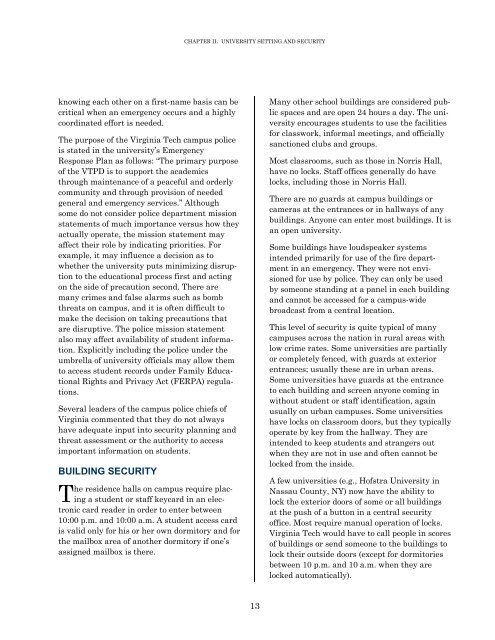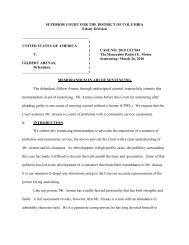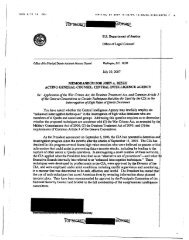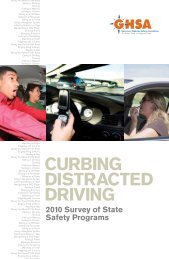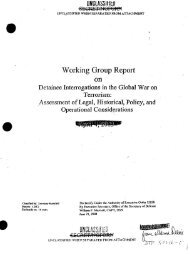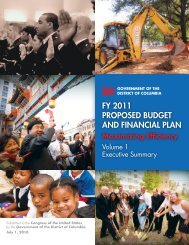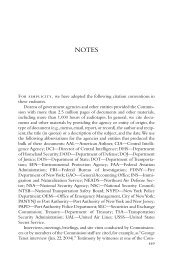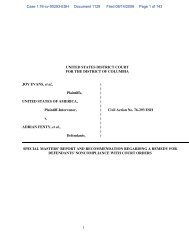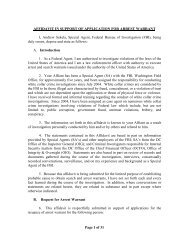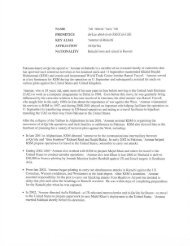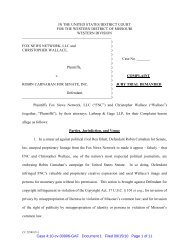Mass Shootings at Virginia Tech
Mass Shootings at Virginia Tech
Mass Shootings at Virginia Tech
You also want an ePaper? Increase the reach of your titles
YUMPU automatically turns print PDFs into web optimized ePapers that Google loves.
knowing each other on a first-name basis can be<br />
critical when an emergency occurs and a highly<br />
coordin<strong>at</strong>ed effort is needed.<br />
The purpose of the <strong>Virginia</strong> <strong>Tech</strong> campus police<br />
is st<strong>at</strong>ed in the university’s Emergency<br />
Response Plan as follows: “The primary purpose<br />
of the VTPD is to support the academics<br />
through maintenance of a peaceful and orderly<br />
community and through provision of needed<br />
general and emergency services.” Although<br />
some do not consider police department mission<br />
st<strong>at</strong>ements of much importance versus how they<br />
actually oper<strong>at</strong>e, the mission st<strong>at</strong>ement may<br />
affect their role by indic<strong>at</strong>ing priorities. For<br />
example, it may influence a decision as to<br />
whether the university puts minimizing disruption<br />
to the educ<strong>at</strong>ional process first and acting<br />
on the side of precaution second. There are<br />
many crimes and false alarms such as bomb<br />
thre<strong>at</strong>s on campus, and it is often difficult to<br />
make the decision on taking precautions th<strong>at</strong><br />
are disruptive. The police mission st<strong>at</strong>ement<br />
also may affect availability of student inform<strong>at</strong>ion.<br />
Explicitly including the police under the<br />
umbrella of university officials may allow them<br />
to access student records under Family Educ<strong>at</strong>ional<br />
Rights and Privacy Act (FERPA) regul<strong>at</strong>ions.<br />
Several leaders of the campus police chiefs of<br />
<strong>Virginia</strong> commented th<strong>at</strong> they do not always<br />
have adequ<strong>at</strong>e input into security planning and<br />
thre<strong>at</strong> assessment or the authority to access<br />
important inform<strong>at</strong>ion on students.<br />
BUILDING SECURITY<br />
T<br />
he residence halls on campus require placing<br />
a student or staff keycard in an electronic<br />
card reader in order to enter between<br />
10:00 p.m. and 10:00 a.m. A student access card<br />
is valid only for his or her own dormitory and for<br />
the mailbox area of another dormitory if one’s<br />
assigned mailbox is there.<br />
CHAPTER II. UNIVERSITY SETTING AND SECURITY<br />
13<br />
Many other school buildings are considered public<br />
spaces and are open 24 hours a day. The university<br />
encourages students to use the facilities<br />
for classwork, informal meetings, and officially<br />
sanctioned clubs and groups.<br />
Most classrooms, such as those in Norris Hall,<br />
have no locks. Staff offices generally do have<br />
locks, including those in Norris Hall.<br />
There are no guards <strong>at</strong> campus buildings or<br />
cameras <strong>at</strong> the entrances or in hallways of any<br />
buildings. Anyone can enter most buildings. It is<br />
an open university.<br />
Some buildings have loudspeaker systems<br />
intended primarily for use of the fire department<br />
in an emergency. They were not envisioned<br />
for use by police. They can only be used<br />
by someone standing <strong>at</strong> a panel in each building<br />
and cannot be accessed for a campus-wide<br />
broadcast from a central loc<strong>at</strong>ion.<br />
This level of security is quite typical of many<br />
campuses across the n<strong>at</strong>ion in rural areas with<br />
low crime r<strong>at</strong>es. Some universities are partially<br />
or completely fenced, with guards <strong>at</strong> exterior<br />
entrances; usually these are in urban areas.<br />
Some universities have guards <strong>at</strong> the entrance<br />
to each building and screen anyone coming in<br />
without student or staff identific<strong>at</strong>ion, again<br />
usually on urban campuses. Some universities<br />
have locks on classroom doors, but they typically<br />
oper<strong>at</strong>e by key from the hallway. They are<br />
intended to keep students and strangers out<br />
when they are not in use and often cannot be<br />
locked from the inside.<br />
A few universities (e.g., Hofstra University in<br />
Nassau County, NY) now have the ability to<br />
lock the exterior doors of some or all buildings<br />
<strong>at</strong> the push of a button in a central security<br />
office. Most require manual oper<strong>at</strong>ion of locks.<br />
<strong>Virginia</strong> <strong>Tech</strong> would have to call people in scores<br />
of buildings or send someone to the buildings to<br />
lock their outside doors (except for dormitories<br />
between 10 p.m. and 10 a.m. when they are<br />
locked autom<strong>at</strong>ically).


